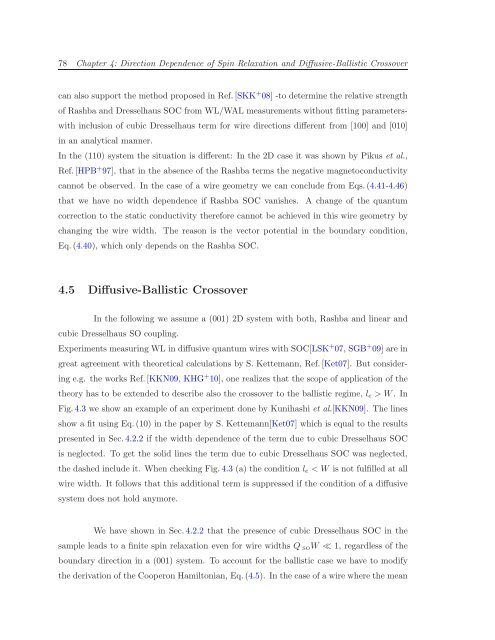Itinerant Spin Dynamics in Structures of ... - Jacobs University
Itinerant Spin Dynamics in Structures of ... - Jacobs University
Itinerant Spin Dynamics in Structures of ... - Jacobs University
Create successful ePaper yourself
Turn your PDF publications into a flip-book with our unique Google optimized e-Paper software.
78 Chapter 4: Direction Dependence <strong>of</strong> <strong>Sp<strong>in</strong></strong> Relaxation and Diffusive-Ballistic Crossover<br />
can also support the method proposed <strong>in</strong> Ref.[SKK + 08] -to determ<strong>in</strong>e the relative strength<br />
<strong>of</strong> Rashba and Dresselhaus SOC from WL/WAL measurements without fitt<strong>in</strong>g parameterswith<br />
<strong>in</strong>clusion <strong>of</strong> cubic Dresselhaus term for wire directions different from [100] and [010]<br />
<strong>in</strong> an analytical manner.<br />
In the (110) system the situation is different: In the 2D case it was shown by Pikus et al.,<br />
Ref.[HPB + 97], that <strong>in</strong> the absence <strong>of</strong> the Rashba terms the negative magnetoconductivity<br />
cannot be observed. In the case <strong>of</strong> a wire geometry we can conclude from Eqs.(4.41-4.46)<br />
that we have no width dependence if Rashba SOC vanishes. A change <strong>of</strong> the quantum<br />
correction to the static conductivity therefore cannot be achieved <strong>in</strong> this wire geometry by<br />
chang<strong>in</strong>g the wire width. The reason is the vector potential <strong>in</strong> the boundary condition,<br />
Eq.(4.40), which only depends on the Rashba SOC.<br />
4.5 Diffusive-Ballistic Crossover<br />
In the follow<strong>in</strong>g we assume a (001) 2D system with both, Rashba and l<strong>in</strong>ear and<br />
cubic Dresselhaus SO coupl<strong>in</strong>g.<br />
Experiments measur<strong>in</strong>g WL <strong>in</strong> diffusive quantum wires with SOC[LSK + 07, SGB + 09] are <strong>in</strong><br />
great agreement with theoretical calculations by S. Kettemann, Ref.[Ket07]. But consider<strong>in</strong>g<br />
e.g. the works Ref.[KKN09, KHG + 10], one realizes that the scope <strong>of</strong> application <strong>of</strong> the<br />
theory has to be extended to describe also the crossover to the ballistic regime, l e > W. In<br />
Fig.4.3 we show an example <strong>of</strong> an experiment done by Kunihashi et al.[KKN09]. The l<strong>in</strong>es<br />
show a fit us<strong>in</strong>g Eq.(10) <strong>in</strong> the paper by S. Kettemann[Ket07] which is equal to the results<br />
presented <strong>in</strong> Sec.4.2.2 if the width dependence <strong>of</strong> the term due to cubic Dresselhaus SOC<br />
is neglected. To get the solid l<strong>in</strong>es the term due to cubic Dresselhaus SOC was neglected,<br />
the dashed <strong>in</strong>clude it. When check<strong>in</strong>g Fig.4.3 (a) the condition l e < W is not fulfilled at all<br />
wire width. It follows that this additional term is suppressed if the condition <strong>of</strong> a diffusive<br />
system does not hold anymore.<br />
We have shown <strong>in</strong> Sec.4.2.2 that the presence <strong>of</strong> cubic Dresselhaus SOC <strong>in</strong> the<br />
sample leads to a f<strong>in</strong>ite sp<strong>in</strong> relaxation even for wire widths Q SO W ≪ 1, regardless <strong>of</strong> the<br />
boundary direction <strong>in</strong> a (001) system. To account for the ballistic case we have to modify<br />
the derivation <strong>of</strong> the Cooperon Hamiltonian, Eq.(4.5). In the case <strong>of</strong> a wire where the mean
















